Research Report: Aboriginal Services Awareness at Conestoga College
VerifiedAdded on 2022/10/10
|7
|1108
|15
Report
AI Summary
This report, prepared for Conestoga College's Aboriginal Services, assesses student awareness of the services offered. The study employs primary data collection through surveys and secondary data through literature reviews. Survey results from 134 respondents reveal low awareness levels regarding the location of the Aboriginal Services office, provided services, and the history of Indigenous peoples in Canada. A significant portion of students are also unaware of the Truth and Reconciliation Commission and related initiatives. The report analyzes these findings, highlighting the need to increase awareness. The literature review supports this by suggesting web-based resources and student engagement strategies to promote services. The conclusion recommends eliminating locational barriers, promoting the services' value, and addressing developmental gaps to improve student engagement and knowledge. The report provides valuable insights into the current state of awareness and offers practical recommendations for improvement within the college community.
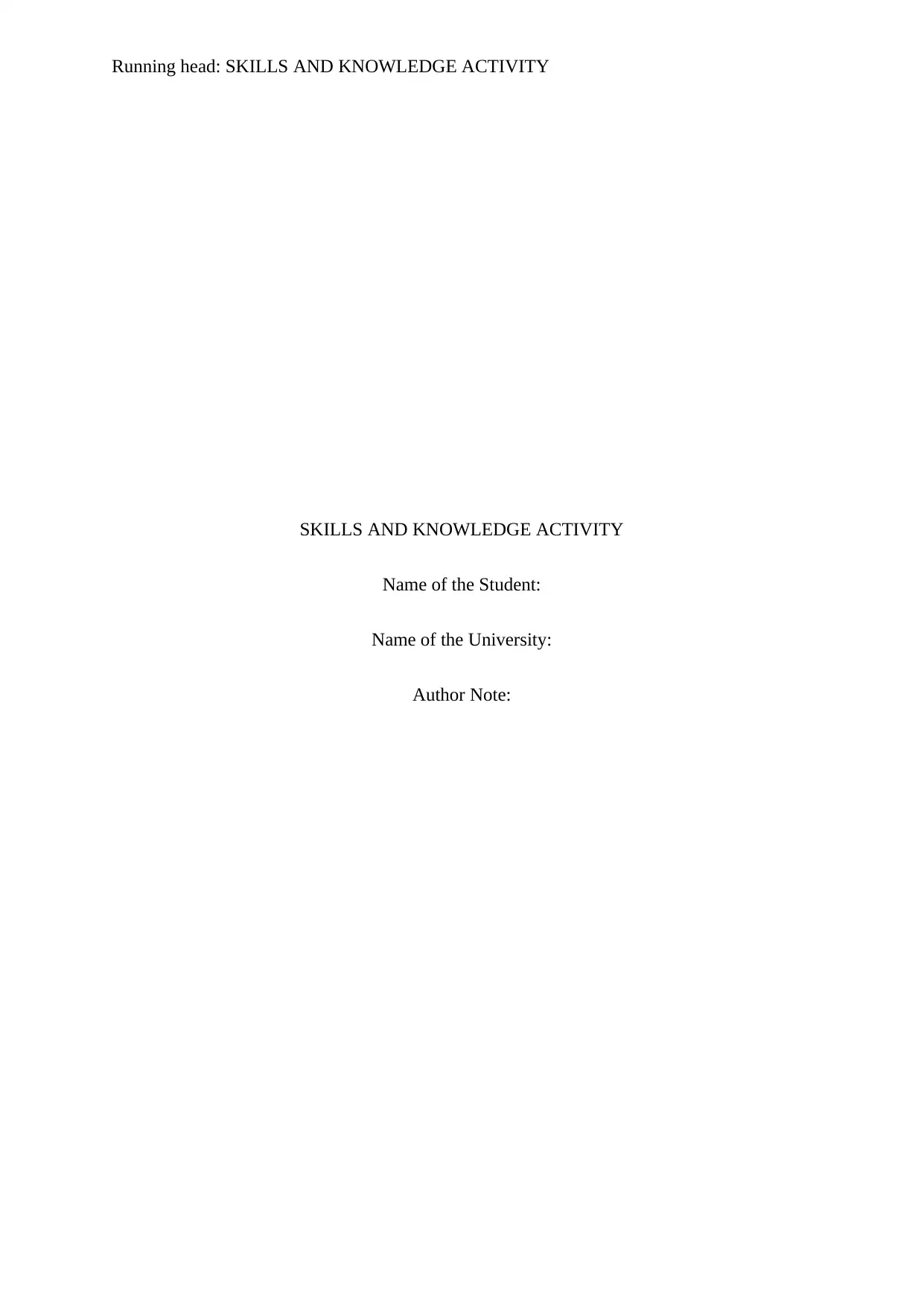
Running head: SKILLS AND KNOWLEDGE ACTIVITY
SKILLS AND KNOWLEDGE ACTIVITY
Name of the Student:
Name of the University:
Author Note:
SKILLS AND KNOWLEDGE ACTIVITY
Name of the Student:
Name of the University:
Author Note:
Paraphrase This Document
Need a fresh take? Get an instant paraphrase of this document with our AI Paraphraser
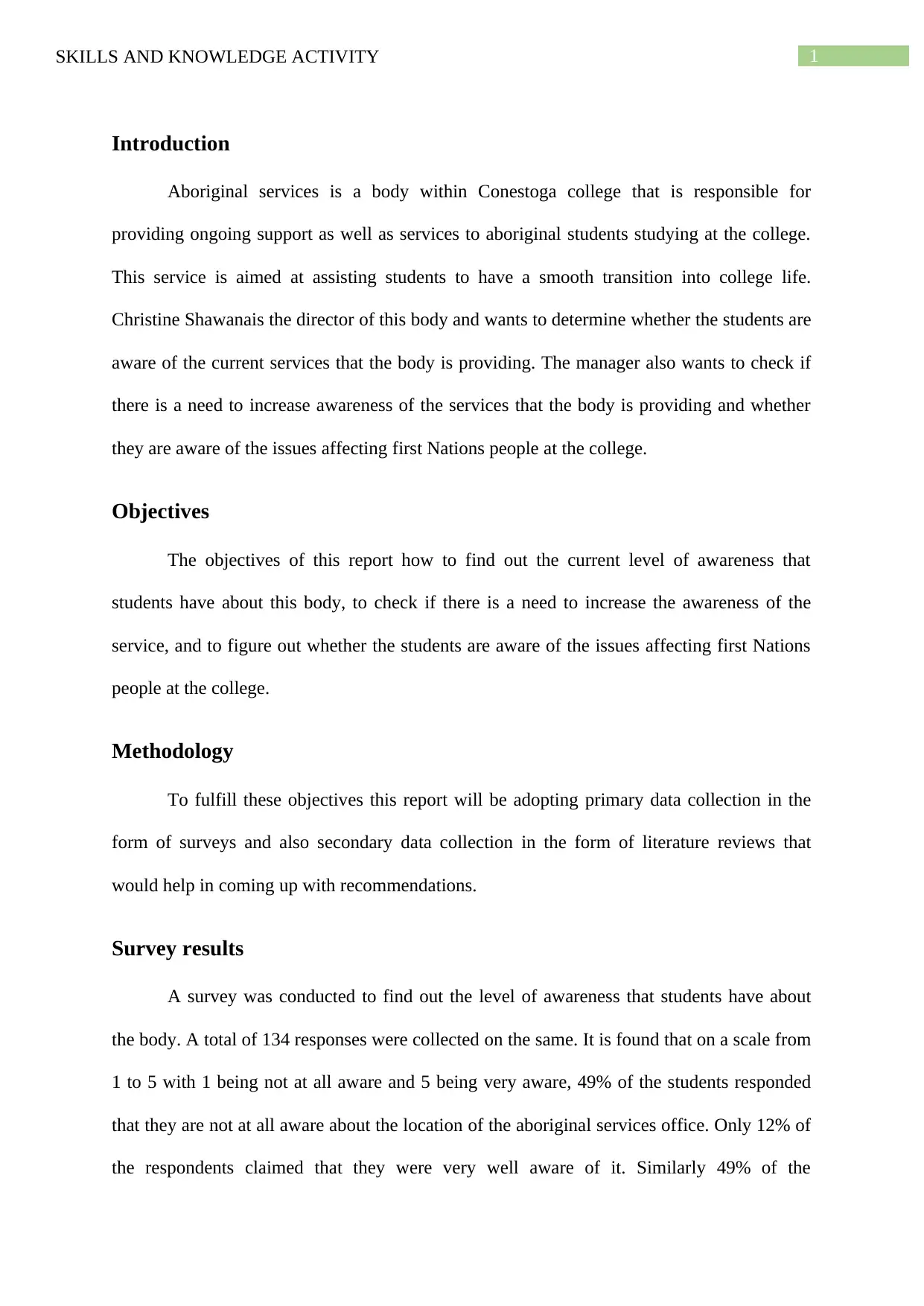
1SKILLS AND KNOWLEDGE ACTIVITY
Introduction
Aboriginal services is a body within Conestoga college that is responsible for
providing ongoing support as well as services to aboriginal students studying at the college.
This service is aimed at assisting students to have a smooth transition into college life.
Christine Shawanais the director of this body and wants to determine whether the students are
aware of the current services that the body is providing. The manager also wants to check if
there is a need to increase awareness of the services that the body is providing and whether
they are aware of the issues affecting first Nations people at the college.
Objectives
The objectives of this report how to find out the current level of awareness that
students have about this body, to check if there is a need to increase the awareness of the
service, and to figure out whether the students are aware of the issues affecting first Nations
people at the college.
Methodology
To fulfill these objectives this report will be adopting primary data collection in the
form of surveys and also secondary data collection in the form of literature reviews that
would help in coming up with recommendations.
Survey results
A survey was conducted to find out the level of awareness that students have about
the body. A total of 134 responses were collected on the same. It is found that on a scale from
1 to 5 with 1 being not at all aware and 5 being very aware, 49% of the students responded
that they are not at all aware about the location of the aboriginal services office. Only 12% of
the respondents claimed that they were very well aware of it. Similarly 49% of the
Introduction
Aboriginal services is a body within Conestoga college that is responsible for
providing ongoing support as well as services to aboriginal students studying at the college.
This service is aimed at assisting students to have a smooth transition into college life.
Christine Shawanais the director of this body and wants to determine whether the students are
aware of the current services that the body is providing. The manager also wants to check if
there is a need to increase awareness of the services that the body is providing and whether
they are aware of the issues affecting first Nations people at the college.
Objectives
The objectives of this report how to find out the current level of awareness that
students have about this body, to check if there is a need to increase the awareness of the
service, and to figure out whether the students are aware of the issues affecting first Nations
people at the college.
Methodology
To fulfill these objectives this report will be adopting primary data collection in the
form of surveys and also secondary data collection in the form of literature reviews that
would help in coming up with recommendations.
Survey results
A survey was conducted to find out the level of awareness that students have about
the body. A total of 134 responses were collected on the same. It is found that on a scale from
1 to 5 with 1 being not at all aware and 5 being very aware, 49% of the students responded
that they are not at all aware about the location of the aboriginal services office. Only 12% of
the respondents claimed that they were very well aware of it. Similarly 49% of the
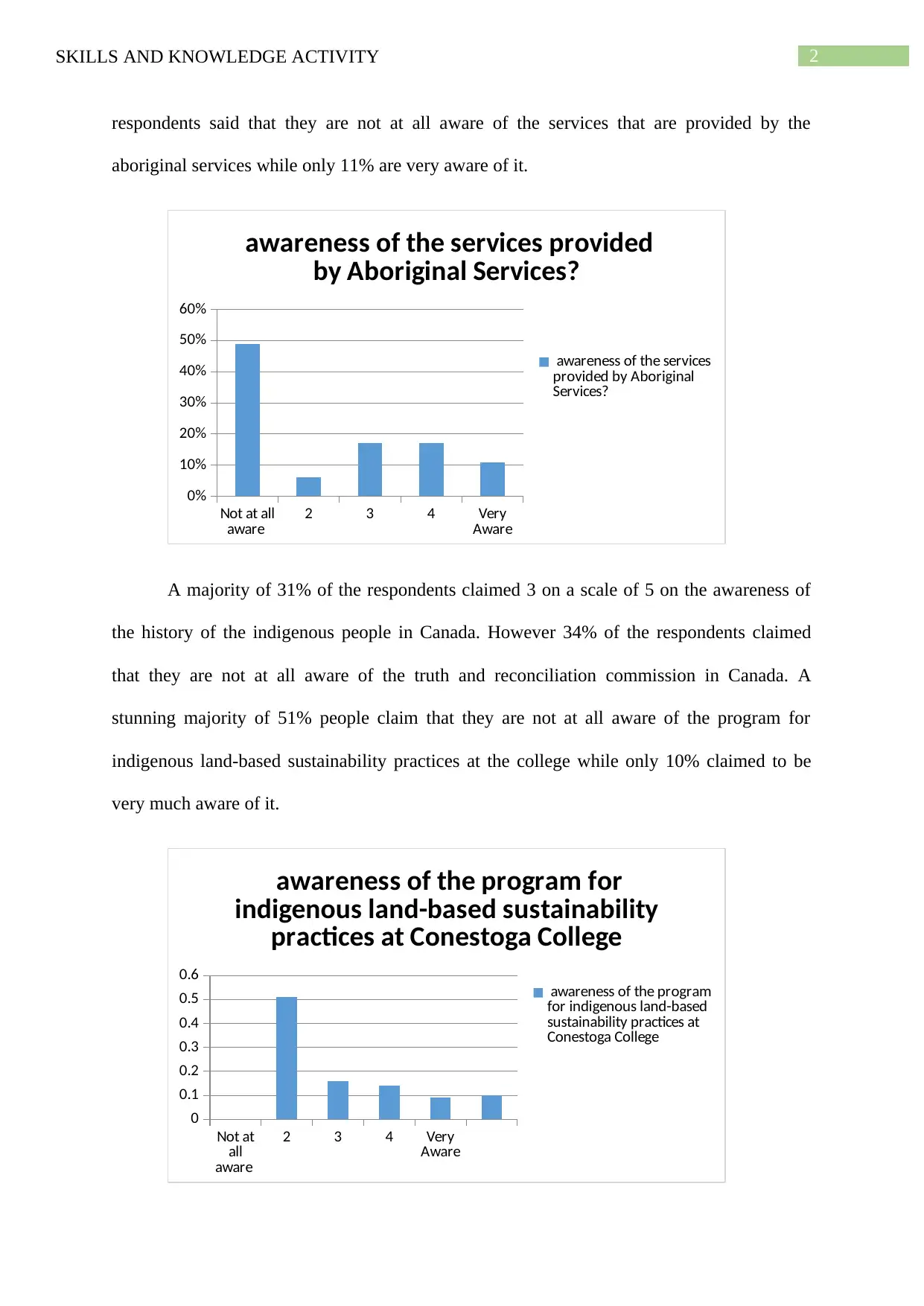
2SKILLS AND KNOWLEDGE ACTIVITY
respondents said that they are not at all aware of the services that are provided by the
aboriginal services while only 11% are very aware of it.
Not at all
aware 2 3 4 Very
Aware
0%
10%
20%
30%
40%
50%
60%
awareness of the services provided
by Aboriginal Services?
awareness of the services
provided by Aboriginal
Services?
A majority of 31% of the respondents claimed 3 on a scale of 5 on the awareness of
the history of the indigenous people in Canada. However 34% of the respondents claimed
that they are not at all aware of the truth and reconciliation commission in Canada. A
stunning majority of 51% people claim that they are not at all aware of the program for
indigenous land-based sustainability practices at the college while only 10% claimed to be
very much aware of it.
Not at
all
aware
2 3 4 Very
Aware
0
0.1
0.2
0.3
0.4
0.5
0.6
awareness of the program for
indigenous land-based sustainability
practices at Conestoga College
awareness of the program
for indigenous land-based
sustainability practices at
Conestoga College
respondents said that they are not at all aware of the services that are provided by the
aboriginal services while only 11% are very aware of it.
Not at all
aware 2 3 4 Very
Aware
0%
10%
20%
30%
40%
50%
60%
awareness of the services provided
by Aboriginal Services?
awareness of the services
provided by Aboriginal
Services?
A majority of 31% of the respondents claimed 3 on a scale of 5 on the awareness of
the history of the indigenous people in Canada. However 34% of the respondents claimed
that they are not at all aware of the truth and reconciliation commission in Canada. A
stunning majority of 51% people claim that they are not at all aware of the program for
indigenous land-based sustainability practices at the college while only 10% claimed to be
very much aware of it.
Not at
all
aware
2 3 4 Very
Aware
0
0.1
0.2
0.3
0.4
0.5
0.6
awareness of the program for
indigenous land-based sustainability
practices at Conestoga College
awareness of the program
for indigenous land-based
sustainability practices at
Conestoga College
⊘ This is a preview!⊘
Do you want full access?
Subscribe today to unlock all pages.

Trusted by 1+ million students worldwide
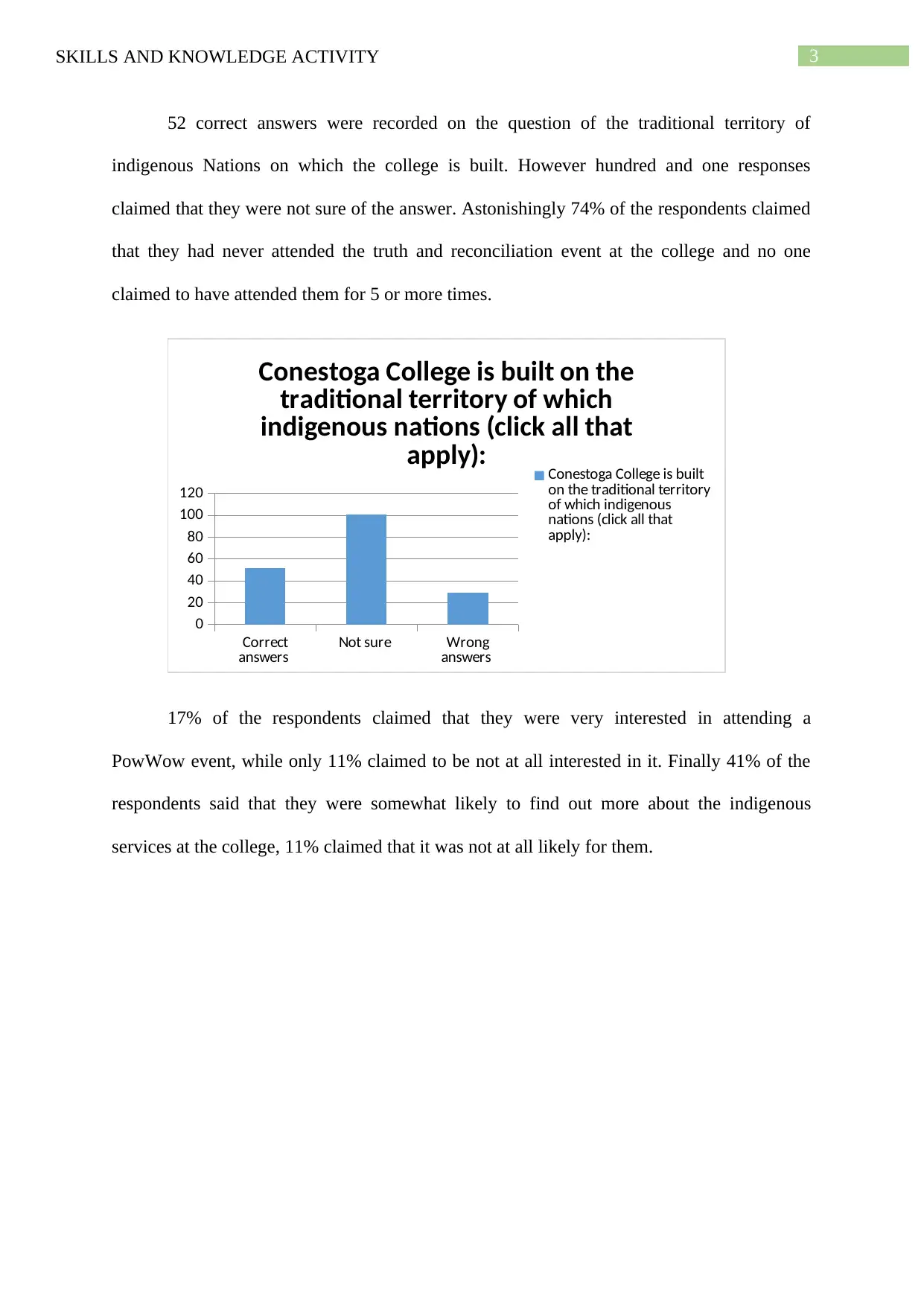
3SKILLS AND KNOWLEDGE ACTIVITY
52 correct answers were recorded on the question of the traditional territory of
indigenous Nations on which the college is built. However hundred and one responses
claimed that they were not sure of the answer. Astonishingly 74% of the respondents claimed
that they had never attended the truth and reconciliation event at the college and no one
claimed to have attended them for 5 or more times.
Correct
answers Not sure Wrong
answers
0
20
40
60
80
100
120
Conestoga College is built on the
traditional territory of which
indigenous nations (click all that
apply): Conestoga College is built
on the traditional territory
of which indigenous
nations (click all that
apply):
17% of the respondents claimed that they were very interested in attending a
PowWow event, while only 11% claimed to be not at all interested in it. Finally 41% of the
respondents said that they were somewhat likely to find out more about the indigenous
services at the college, 11% claimed that it was not at all likely for them.
52 correct answers were recorded on the question of the traditional territory of
indigenous Nations on which the college is built. However hundred and one responses
claimed that they were not sure of the answer. Astonishingly 74% of the respondents claimed
that they had never attended the truth and reconciliation event at the college and no one
claimed to have attended them for 5 or more times.
Correct
answers Not sure Wrong
answers
0
20
40
60
80
100
120
Conestoga College is built on the
traditional territory of which
indigenous nations (click all that
apply): Conestoga College is built
on the traditional territory
of which indigenous
nations (click all that
apply):
17% of the respondents claimed that they were very interested in attending a
PowWow event, while only 11% claimed to be not at all interested in it. Finally 41% of the
respondents said that they were somewhat likely to find out more about the indigenous
services at the college, 11% claimed that it was not at all likely for them.
Paraphrase This Document
Need a fresh take? Get an instant paraphrase of this document with our AI Paraphraser
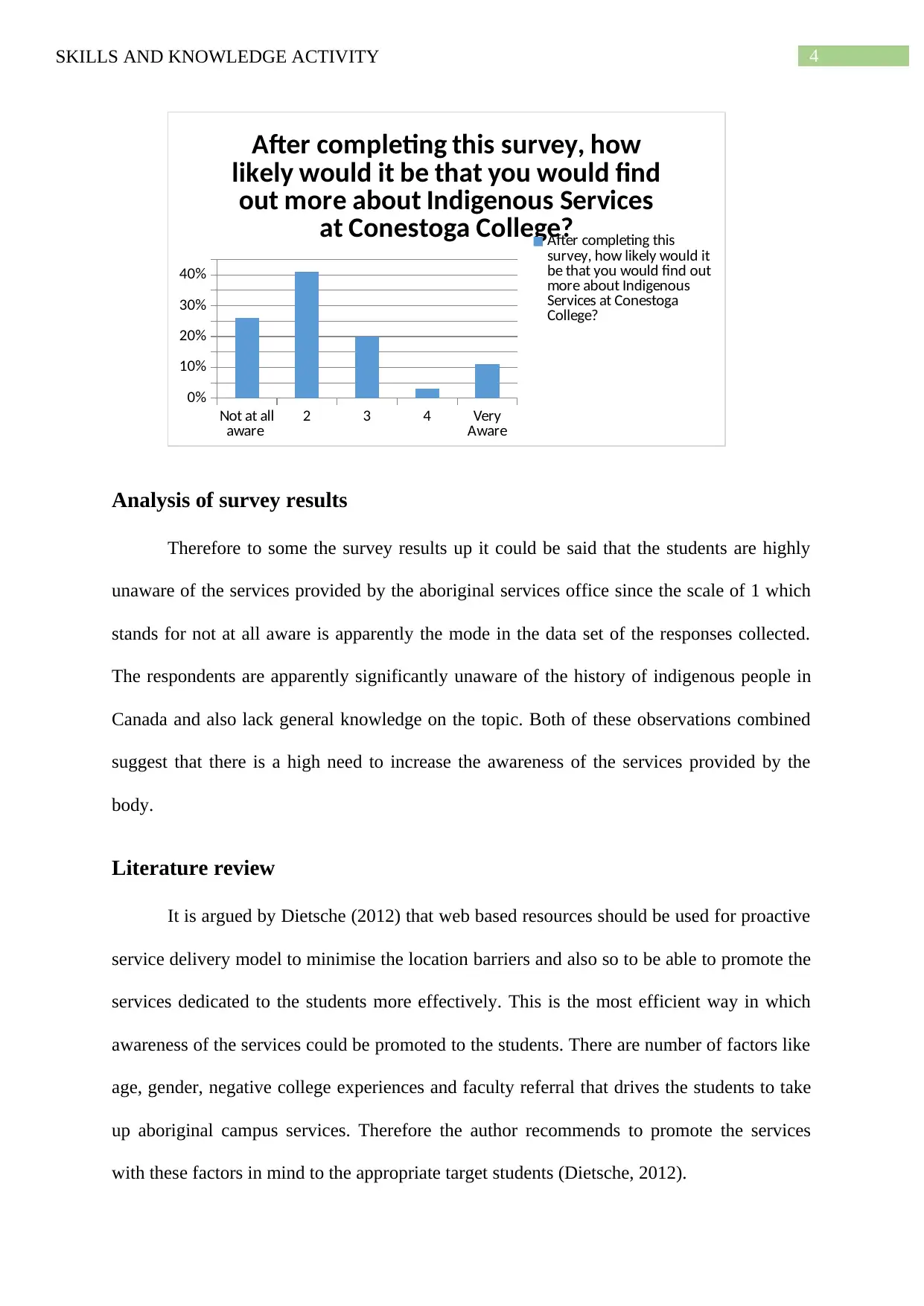
4SKILLS AND KNOWLEDGE ACTIVITY
Not at all
aware 2 3 4 Very
Aware
0%
10%
20%
30%
40%
After completing this survey, how
likely would it be that you would find
out more about Indigenous Services
at Conestoga College?After completing this
survey, how likely would it
be that you would find out
more about Indigenous
Services at Conestoga
College?
Analysis of survey results
Therefore to some the survey results up it could be said that the students are highly
unaware of the services provided by the aboriginal services office since the scale of 1 which
stands for not at all aware is apparently the mode in the data set of the responses collected.
The respondents are apparently significantly unaware of the history of indigenous people in
Canada and also lack general knowledge on the topic. Both of these observations combined
suggest that there is a high need to increase the awareness of the services provided by the
body.
Literature review
It is argued by Dietsche (2012) that web based resources should be used for proactive
service delivery model to minimise the location barriers and also so to be able to promote the
services dedicated to the students more effectively. This is the most efficient way in which
awareness of the services could be promoted to the students. There are number of factors like
age, gender, negative college experiences and faculty referral that drives the students to take
up aboriginal campus services. Therefore the author recommends to promote the services
with these factors in mind to the appropriate target students (Dietsche, 2012).
Not at all
aware 2 3 4 Very
Aware
0%
10%
20%
30%
40%
After completing this survey, how
likely would it be that you would find
out more about Indigenous Services
at Conestoga College?After completing this
survey, how likely would it
be that you would find out
more about Indigenous
Services at Conestoga
College?
Analysis of survey results
Therefore to some the survey results up it could be said that the students are highly
unaware of the services provided by the aboriginal services office since the scale of 1 which
stands for not at all aware is apparently the mode in the data set of the responses collected.
The respondents are apparently significantly unaware of the history of indigenous people in
Canada and also lack general knowledge on the topic. Both of these observations combined
suggest that there is a high need to increase the awareness of the services provided by the
body.
Literature review
It is argued by Dietsche (2012) that web based resources should be used for proactive
service delivery model to minimise the location barriers and also so to be able to promote the
services dedicated to the students more effectively. This is the most efficient way in which
awareness of the services could be promoted to the students. There are number of factors like
age, gender, negative college experiences and faculty referral that drives the students to take
up aboriginal campus services. Therefore the author recommends to promote the services
with these factors in mind to the appropriate target students (Dietsche, 2012).
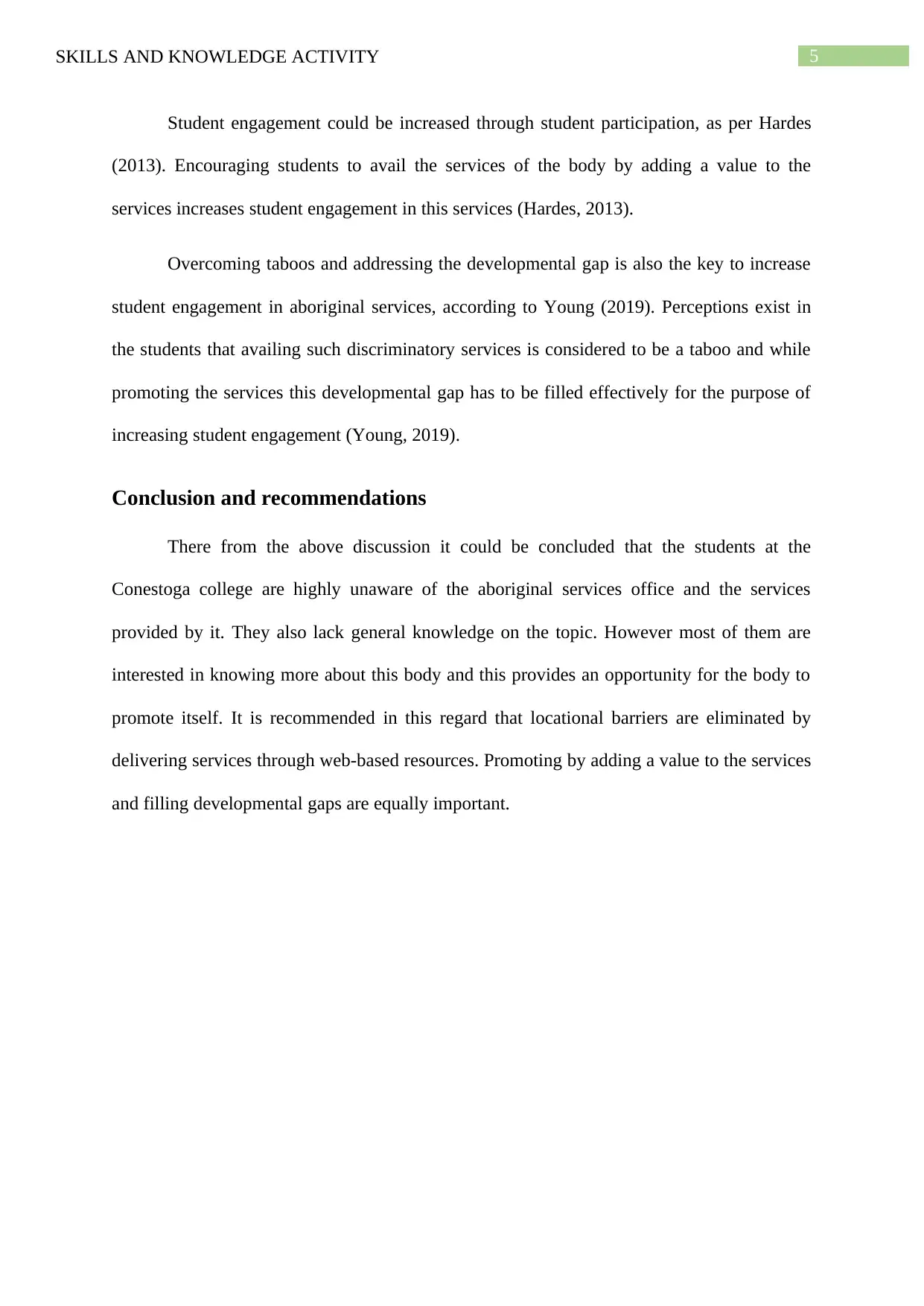
5SKILLS AND KNOWLEDGE ACTIVITY
Student engagement could be increased through student participation, as per Hardes
(2013). Encouraging students to avail the services of the body by adding a value to the
services increases student engagement in this services (Hardes, 2013).
Overcoming taboos and addressing the developmental gap is also the key to increase
student engagement in aboriginal services, according to Young (2019). Perceptions exist in
the students that availing such discriminatory services is considered to be a taboo and while
promoting the services this developmental gap has to be filled effectively for the purpose of
increasing student engagement (Young, 2019).
Conclusion and recommendations
There from the above discussion it could be concluded that the students at the
Conestoga college are highly unaware of the aboriginal services office and the services
provided by it. They also lack general knowledge on the topic. However most of them are
interested in knowing more about this body and this provides an opportunity for the body to
promote itself. It is recommended in this regard that locational barriers are eliminated by
delivering services through web-based resources. Promoting by adding a value to the services
and filling developmental gaps are equally important.
Student engagement could be increased through student participation, as per Hardes
(2013). Encouraging students to avail the services of the body by adding a value to the
services increases student engagement in this services (Hardes, 2013).
Overcoming taboos and addressing the developmental gap is also the key to increase
student engagement in aboriginal services, according to Young (2019). Perceptions exist in
the students that availing such discriminatory services is considered to be a taboo and while
promoting the services this developmental gap has to be filled effectively for the purpose of
increasing student engagement (Young, 2019).
Conclusion and recommendations
There from the above discussion it could be concluded that the students at the
Conestoga college are highly unaware of the aboriginal services office and the services
provided by it. They also lack general knowledge on the topic. However most of them are
interested in knowing more about this body and this provides an opportunity for the body to
promote itself. It is recommended in this regard that locational barriers are eliminated by
delivering services through web-based resources. Promoting by adding a value to the services
and filling developmental gaps are equally important.
⊘ This is a preview!⊘
Do you want full access?
Subscribe today to unlock all pages.

Trusted by 1+ million students worldwide
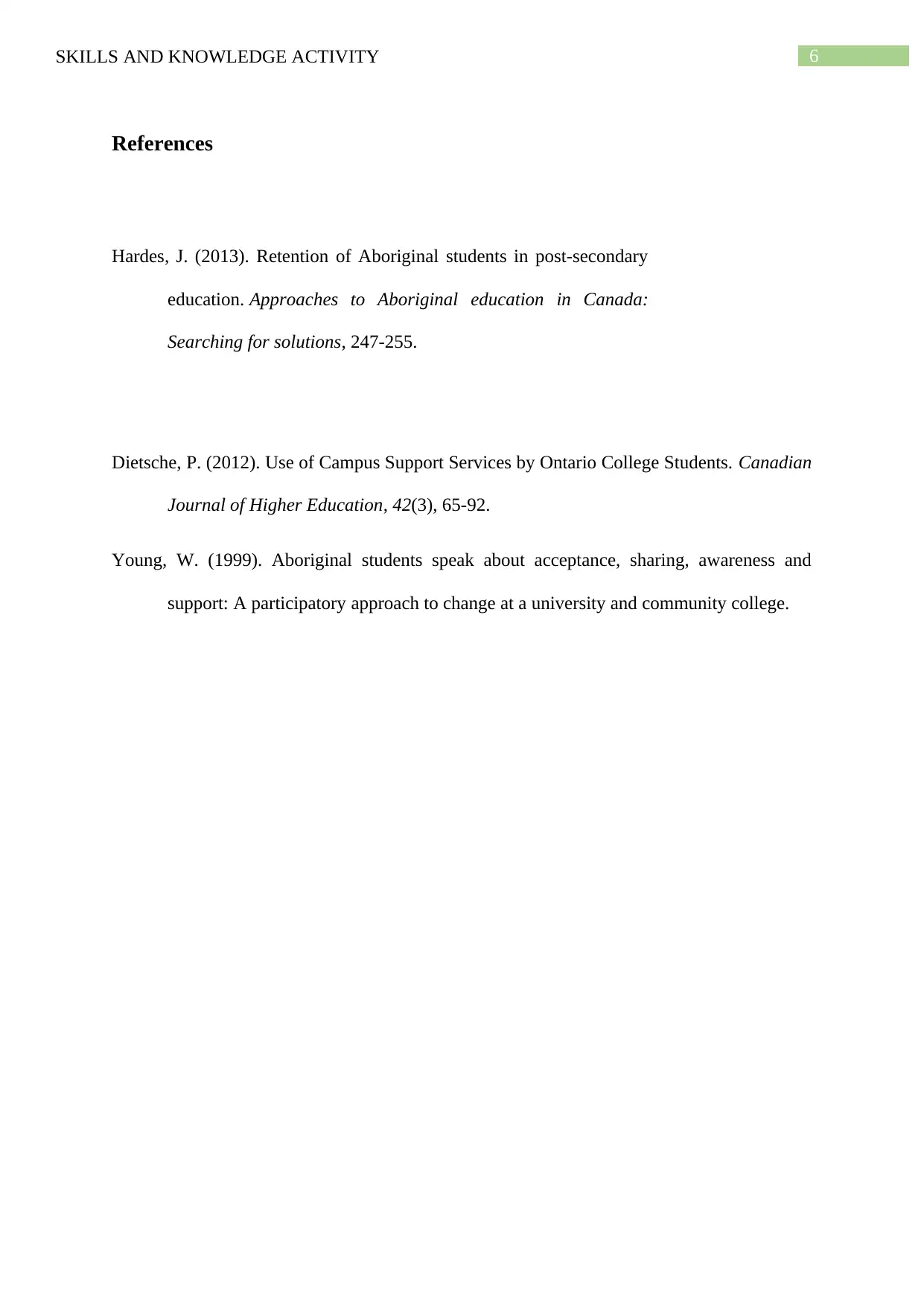
6SKILLS AND KNOWLEDGE ACTIVITY
References
Hardes, J. (2013). Retention of Aboriginal students in post-secondary
education. Approaches to Aboriginal education in Canada:
Searching for solutions, 247-255.
Dietsche, P. (2012). Use of Campus Support Services by Ontario College Students. Canadian
Journal of Higher Education, 42(3), 65-92.
Young, W. (1999). Aboriginal students speak about acceptance, sharing, awareness and
support: A participatory approach to change at a university and community college.
References
Hardes, J. (2013). Retention of Aboriginal students in post-secondary
education. Approaches to Aboriginal education in Canada:
Searching for solutions, 247-255.
Dietsche, P. (2012). Use of Campus Support Services by Ontario College Students. Canadian
Journal of Higher Education, 42(3), 65-92.
Young, W. (1999). Aboriginal students speak about acceptance, sharing, awareness and
support: A participatory approach to change at a university and community college.
1 out of 7
Related Documents
Your All-in-One AI-Powered Toolkit for Academic Success.
+13062052269
info@desklib.com
Available 24*7 on WhatsApp / Email
![[object Object]](/_next/static/media/star-bottom.7253800d.svg)
Unlock your academic potential
Copyright © 2020–2025 A2Z Services. All Rights Reserved. Developed and managed by ZUCOL.





